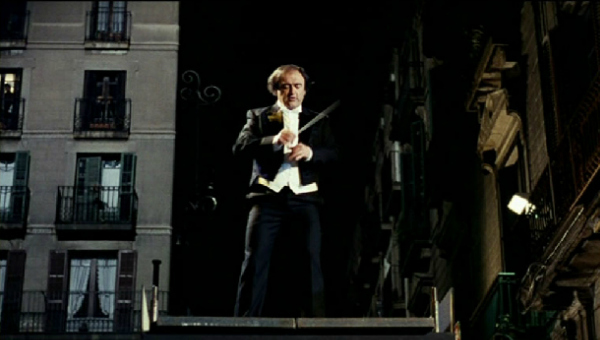 WARSAW BRIDGE is decidedly oblique. Studiously ignoring linear narrative conventions, Pere Portabella has fashioned a film which is held together without plot, and with no narrative progression to speak of. Instead, themes, tropes and characters are allowed to develop outside of a recognisable storyline. Yet the director’s methods may not simply be dismissed as experimental. WARSAW BRIDGE is not a ‘difficult’ film to watch. On the contrary, the scenes develop with confidence and an easy visual style that belies the obscurity of their content.
WARSAW BRIDGE is decidedly oblique. Studiously ignoring linear narrative conventions, Pere Portabella has fashioned a film which is held together without plot, and with no narrative progression to speak of. Instead, themes, tropes and characters are allowed to develop outside of a recognisable storyline. Yet the director’s methods may not simply be dismissed as experimental. WARSAW BRIDGE is not a ‘difficult’ film to watch. On the contrary, the scenes develop with confidence and an easy visual style that belies the obscurity of their content.
… the meta-artistic comments must be seen for the fragments they are …
Early in the film, a conductor sets himself up on a tall plinth on a busy street. As his hands and arms begin to move, conducting the piece, diegetic music drifts down the street. People stop to watch this madman waving his arms and conjuring music. As the crowd stands transfixed, the various musicians of the orchestra are revealed to be perched on balconies and rooftops throughout the narrow city streets, with a live feed of the conductor being channelled to them. It’s a sort of deconstructed flash-mob, and appears to be entirely divorced from the preceding scenes. In a literal sense, it is. But the underlying purpose of this section is to place a yardstick against which all subsequent scenes may be judged. By the end of the film, you will think nothing of Rubenesque ladies singing in a bathhouse, or a pair of opera singers rising up on forklift trucks in the middle of a dawn fish market.
For some, Portabella’s film will be impossibly arthouse. However, if you allow the dynamic cinematography and intriguing script to seduce you, it has a strange and compelling internal logic. The constant meditations on the validity of art in all its forms seem to provide a key to the film, but it is a false dawn. Instead, the meta-artistic comments must be seen for the fragments they are. Once you understand the balkanisation of WARSAW BRIDGE – how a single idea or concept may be split across many scenes and characters – you can start to see the logic, and feel the benefit of the images.

